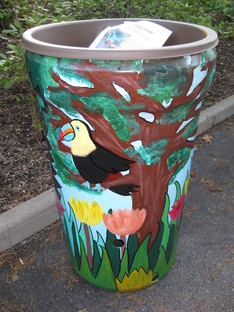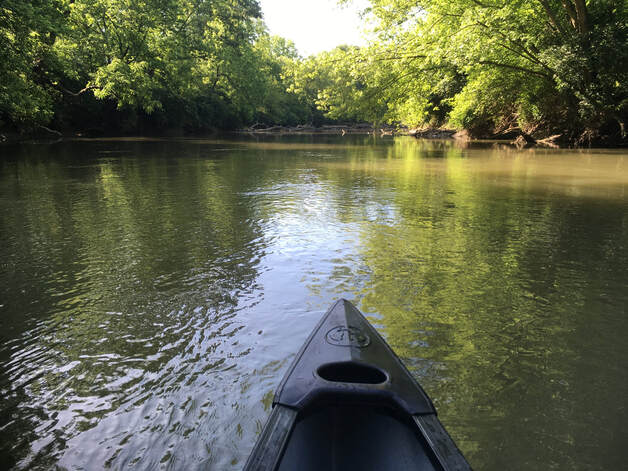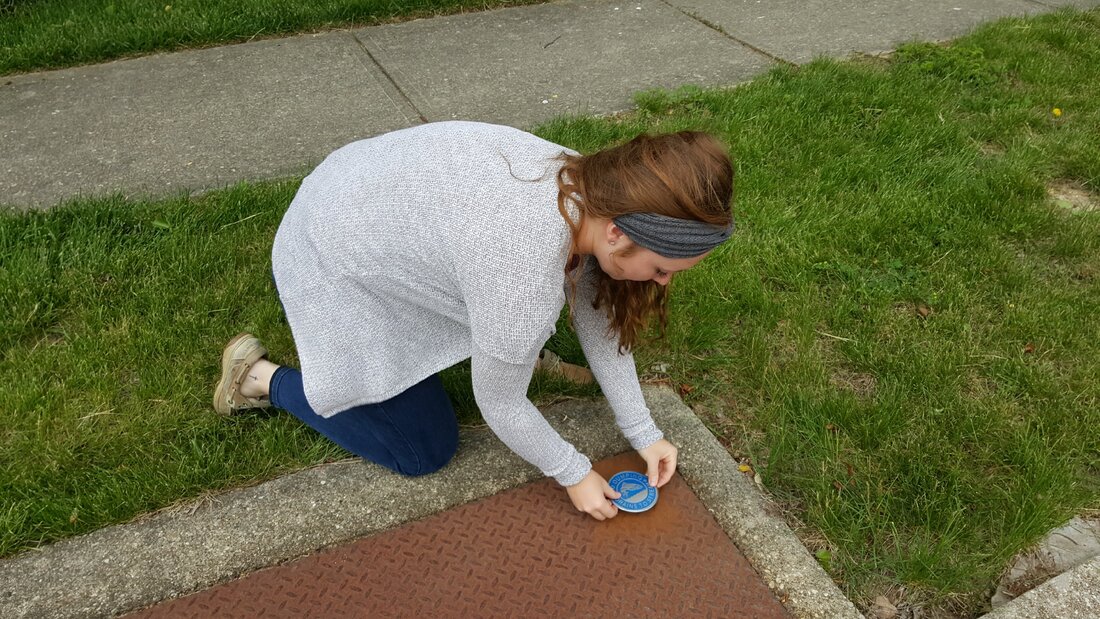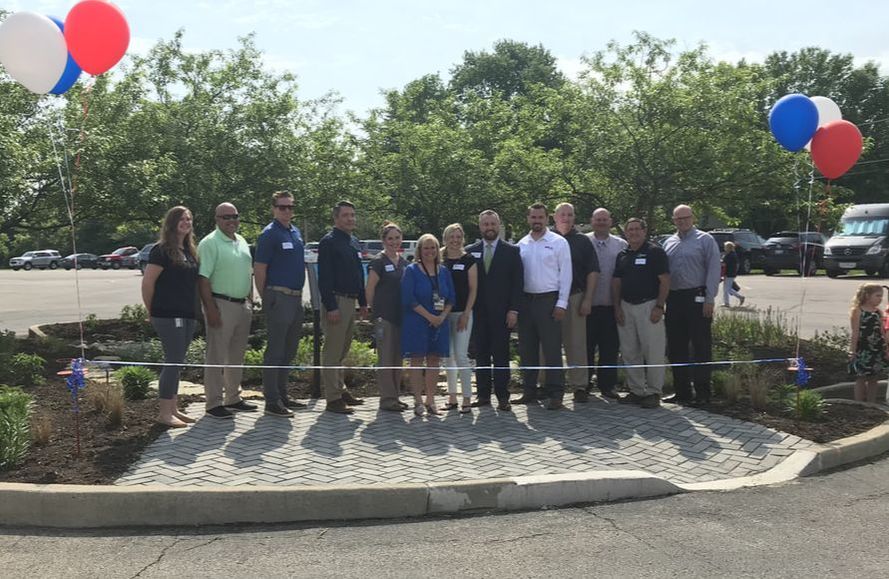|
Whether you fish, kayak or just simply sit by the shores of a beautiful lake, having clean lakes and rivers is something we can all appreciate. But did you ever think about how our water travels and ends up in these bodies of water? The USGS website (usgs.gov) explains how water travels best: “When rain falls onto the earth, it doesn’t just sit there, it starts moving according to the laws of gravity. A portion of the precipitation seeps into the ground to replenish the Earth's groundwater. Most of it flows downhill as runoff. Runoff is extremely important in that not only does it keep rivers and lakes full of water, but it also changes the landscape by the action of erosion. In cases of developed areas where stormwater cannot infiltrate into the ground because of impervious areas, more runoff occurs. In urbanized areas, runoff must be collected by “extensive drain systems that consist of curbs, storm sewers, and ditches to carry stormwater directly to streams. More simply, in a developed watershed, much more water arrives into a stream more quickly, resulting in an increased likelihood of more frequent and more severe flooding.” “As it flows over the lands and other surfaces, stormwater picks up potential pollutants that may include sediment, nutrients (from lawn/agriculture fertilizers), bacteria (from animal and human waste), pesticides (from lawn and garden/agriculture chemicals), metals (from rooftops and roadways), and petroleum by-products (from leaking vehicles).” We also have situations where people dump prohibited materials (anything that is not stormwater) directly into storm drains not thinking of the impact that it has down stream. Polluted stormwater runoff can be harmful to plants, animals, and people. Understanding that our water systems are all connected and by helping to keep our stormwater clean, can help keep our rivers, lakes and streams clean. Help out our local water systems by keeping “only rain, down the storm drain.”  Here are some items that you can do to help:
2 Comments
In the last few years we have experienced record rainfall events. While rainfall (otherwise known as stormwater) is a natural occurrence, unfortunately our environment is not always in a “natural” state. In other words, we have developed areas such as roads, sidewalks, roof tops, parking lots and other impervious surfaces where stormwater does not have a chance to soak down into our soil. This stormwater becomes runoff and picks up pollutants from our lawns and streets (examples - vehicle emissions, oil residue, grass clippings, pesticides, leaves, and pet waste) and enters our lakes and streams by way of storm drains thus causing water pollution and impairments within our local bodies of water. Stormwater runoff is the number one threat to our water quality according to the U.S. Environmental Protection Agency. How can we help? Below are some simple management ideas that could be implemented within the landscape to help store and clean some of this stormwater thus lessening the amount of water entering our stormwater sewer systems.  Utilizing Rain Barrels Rain barrels connect to downspouts to collect rain water. The collected water can then be used to water gardens, and be used as grey water for washing outdoor items. Water collected from rain barrels is not for human consumption, however. Some of the other benefits of rain barrels include:
 Creating a Rain Garden Rain gardens are a unique feature that can be added to the landscape and is disguised as a flower garden. They have many benefits that include: providing wildlife habitat, providing nectar and pollen sources for pollinators, transforming rainfall runoff into a resource rather than a nuisance, and improving storm water quality as it is infiltrated and redistributed through soils. Rain gardens are purposefully located to maximize the amount of stormwater runoff that flows into the garden rather than off the property. It is important to note that it is not just a garden bed. Garden size, depth, slope, soil amendments and drainage all need to be considered before putting a shovel into the ground. Plants that thrive in your landscape and in southwest Ohio should be considered. Native plants are good choices because they tend to offer more benefits to pollinators and have better survivability in native soils. To help prepare your rain garden’s site, check out the following resources:
Before putting any of these water management strategies into place, please check local ordinances to make sure you understand what is allowable. For more questions regarding rain barrels and rain gardens, contact us! 513-695-1337.  Often people think that disposing of waste liquids, products, etc. down a drain is ideal because eventually it all gets cleaned out at a wastewater treatment plant. After all, all drains go to the same place right? The answer to that question however is NO. It is important to understand the difference between sanitary sewers and storm sewers so we can protect our water resources. The sanitary sewer is a system of subsurface pipes that carries sewage from bathrooms, sinks, kitchens, and other plumbing components to a wastewater treatment plant where it is filtered and treated before being discharged. The storm sewer however is a system designed to carry rainfall runoff and other drainage. It is not designed to carry sewage or hazardous wastes that can enter the environment as pollution. The runoff is carried in subsurface pipes and/or open ditches and discharges untreated into local streams, rivers and other surface water bodies. Storm drain inlets are typically found in curbs and low-lying outdoor areas. Some older buildings have basement floor drains that connect to the storm sewer system. (MSU WATER) Disposal of chemicals or hazardous substances to the storm sewer system damages the environment. Motor oil, cleaners, paints and other common household items that get into storm drains can poison fish, birds, and other wildlife, and can find their way into drinking water supplies. In addition, grass clippings, leaves, litter, and organic matter can clog storm drains, cause flooding, and increase nutrient pollution in waterways. You may have seen storm drain tags placed by Warren County SWCD reminding people "Only Rain Down the Drain" and other similar messaging to help protect our environment and water resources. There are a wide range of things people can do at home to help safeguard our water sources; from installation of rain gardens and rain barrels to slow down stormwater runoff to washing your car NOT in the impervious driveway. But simply put, only rain water should enter our storm drains! To find out more about what you can do to help prevent water pollution, visit our Partners at Save Local Waters! This morning we celebrated the success of the J.F. Burns Elementary School Rain Garden Project with a ribbon cutting ceremony! Representatives from all project partners, along with students and teachers gathered around the rain garden to celebrate this special project. The program included an award presentation, ribbon cutting, and a performance by the elementary school choir. What is a rain garden? A rain garden is a planted area that collects rainwater runoff from impervious surfaces, like the parking lot, and allows the water to absorb back into the ground. The plants act as a sponge to soak up the water and work to remove the pollutants from the parking lot runoff. Rain gardens also provide habitat for wildlife, including our very important pollinators. Butterflies and bees will visit here often to collect nectar from the flowers. How does a rain garden work? When it rains, storm drains along roads and parking lots carry rainwater to our streams and rivers. By redirecting water into a rain garden on the campus of J.F. Burns Elementary, we are preventing pollution from flowing downstream to Landen Lake. Rain gardens also provide habitat for wildlife, including our very important pollinators. We are very fortunate to work with local partners to complete projects like the J.F. Burns Elementary School Rain Garden within our county. Projects like this one have a variety of benefits including beautification, education and water quality improvements for the school and the local watershed. Partners on this project include Deerfield Regional Storm Water District, Deerfield Township Kings Local Schools, MSP Design, United Way, Evans Landscaping and Reading Rock.  Calling all artists! The 6th annual Rain Barrel Art Project has begun and we are looking for individuals or groups to submit ideas of art they would like to paint on a rain barrel. The entry period is open until January 22. Click here to submit your idea. 2018 Project Timeline Nov. 15 (of 2017) to Jan. 22 - Entry Period (Click here to submit artwork) Jan. 23 to Jan. 29 - Selection Period Feb 10 - Artist Workshop @ The Cincinnati Zoo Feb. 10 to Mar. 29 - Painting Period Mar. 29 to Mar 31 - Rain Barrel Dropoff @ The Cincinnati Zoo Apr. 1 - Apr. 19 - Rain Barrels Displayed @ The Cincinnati Zoo Apr. 9 to 19 - Rain Barrel Art Online Auction April 19 - Party for the Planet, Auction Finale, and Artist Reception How do I participate? 1. Go to the entry form and submit your idea for approval. 2. If your design is approved, attend the artist workshop on February 10. 3. Pick up your rain barrel at the end of the workshop. 4. Return your rain barrel by Mar. 31 and visit it at the Cincinnati Zoo. What happens after I return the barrel? 1. Barrels are displayed throughout the Zoo between April 1 and April 19. 2. Barrels will be auctioned online between April 9 and April 19. 3. The money raised from the auction will be used for environmental education at SaveLocalWaters.org and at the Zoo. Rain barrels continue to grow in popularity across the country. However, one of its biggest drawbacks is their dull appearance. Some people are less likely to use them given the lack of aesthetic value they offer to residential and commercial landscaping, even though they conserve water and save money. We believe that producing beautiful artistic rain barrels that have unique painted details will make them more desirable and naturally promote their use. The Rain Barrel Art Project is designed to educate people on environmental issues like storm water runoff, watersheds and water conservation. To learn more about this project and other stormwater education campaigns visit SaveLocalWaters.org |
Details
Warren County SWCD Staff BlogA blog to keep you informed on all the latest news at Warren County SWCD and in the conservation world. Archives
May 2024
Categories
All
|
|
|
Contact:PHONE: (513) 695 - 1337
EMAIL: [email protected] HOURS: Monday - Friday 7:30am - 4:00pm (except holidays) Connect:Warren County Soil & Water Conservation District Copyright © 2016
Warren SWCD Privacy Notice. Emails are serviced by Constant Contact. Constant Contact's Privacy Notice. |





